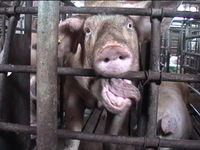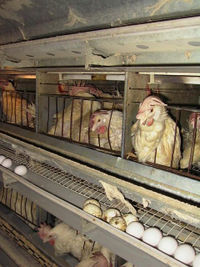McCruelty to Go
McCruelty to Go is a subsection of the main SourceWatch article McDonald's.
Contents
McDonald's & animal welfare issues
Dismembering cows alive
In 1999, McDonald’s was nominated by Business Ethics Magazine for its' prestigious Business Ethics Award. However, the magazine decided not to grant them the award due to animal welfare issues and concerns. According to an open letter from the judges, published in the November/December 1999 issue:
- "We must express concern about slaughterhouse cruelty by McDonald’s suppliers. ...Federal standards require that 100 percent of cows be fully stunned before they are skinned, but (according to) a McDonald’s training video ...it’s acceptable if five cows in every 100 are conscious while skinned and dismembered. It’s inhumane to allow animals to suffer in this manner. And the real error rate may be far more than 5 percent ...In the case of chickens, U.S. Department of Agriculture (USDA) recommendations say they should have at least 2 square feet of space, yet McDonald’s suppliers allow only .55 square feet—not enough space for a chicken to spread one wing. In addition, birds are bred to grow so large, their legs can’t bear the weight, and they suffer painful leg deformities. Surely it’s not asking too much to change policies, so that these animals are granted a modicum of comfort."
Although McDonald’s referred to itself as an "industry leader in animal welfare", the editors were aware of McLibel. In 1997, when Chief Justice Roger Bell of the British High Court in London returned his lengthy findings, he cited McDonald's as "culpably responsible" for animal cruelty. An Appeals Court judge agreed, "Keeping large numbers of chickens in close confinement inevitably leads to disease ...The high density is intentional and unnecessary. ...In my judgement it’s cruel." McDonald’s is largest purchaser of beef and the second largest purchaser of poultry in the United States. [1]
"McCruelty to Go" campaign
In 1997, People for the Ethical Treatment of Animals (PETA), contacted McDonald's to request that the company take several specific steps to reduce unnecessary animal suffering. PETA offered both assistance and a public acknowledgment of the company's leadership in reducing animal suffering; if only they would follow through on its prior stated "commitment to animal welfare." For two years, PETA engaged in a series of frustrating discussions and negotiations with McDonald's. During this time, McDonald's continued to insist in counter campaigning that "industry practice" only seemed cruel to the "inexperienced observer" and was actually "for the animals own good". Furthermore, their critics "simply did not understand animal welfare".
Dr. Temple Grandin has designed the systems in meat processing plants for nearly half the cattle in North America and is McDonald's livestock handling consultant. When she was asked for her input, she indicated that with almost no effort, the corporation could require suppliers to hire two stunners. This simple measure would markedly decrease the number of animals who are skinned and dismembered alive. The company chose not to do so. She also noted that the current methods of catching chickens for slaughter caused a high incidence of trauma (broken wings and legs). Dr. Grandin pointed out British incentives which were in place to reduce trauma incidents. McDonald's also ignored this advice, in spite of lip service to the Associated Press that:
- "if Dr. Grandin sees a problem, we correct it."[2]
Another consultant informed McDonald's that there were reliable sources of humanely raised cows and pigs if the restaurant chain would commit to purchasing them. Their response was that they were "already the leader in animal welfare issues". After two years of frustrating discussions, PETA launched its international "McCruelty to Go" campaign in 1999. [3], [4]
Sow gestation crates
McDonalds and Walmart reportly requested that Smithfield Foods and other pig producers quit using gestation crates after a panel concluded they were inhumane and unnecessary. The panel was appointed by McDonald's as part of a 1994 negotiation with Coalition for Nonviolent Food founder Henry Spira, who died in 1998. [5] In June of 2009, Smithfield announced it could not afford to go through with its highly publicized animal welfare improvements. The company announced it would delay plans to replace “gestation crates” for pregnant sows with more humane “group housing." [6] (Again, McDonald's has ignored advice from its own consultant, to purchase from reliable sources of humanely raised cows and pigs.)[7]
Suppliers
Tyson Foods is also major supplier of restaurant chains, including McDonald's.[8] Both Tyson and Smithfield Foods have long histories of appalling animal abuses as well as health, safety, environmental and employee abuses in the U.S. and other countries. Many of them have been investigated, documented and exposed by PETA and other animal rights and welfare groups. See also Tyson Foods & Smithfield Foods.
Battery hen cages
In April of 2010, McDonald’s board recommended that company shareholders reject a modest, animal welfare proposal requiring that 5 % of eggs be purchased in the U.S. be from cage free suppliers. The proposal was advanced by the Humane Society of the United States (HSUS). Other fast food chains, have made some level of commitments to purchasing or selling cage free eggs. However, according to McDonald's Board of Directors, the "science" was not there to support a switch. McDonald’s suppliers may use “battery cages” that afford a minimum of 72 square inches of floor space per hen. An area, the HSUS argues, which is not even large enough for a hen to fully spread her wings. [9] In a proxy statement issued by McDonald's Board of Directors, it was conceded that eggs produced in current conditions have a 250% higher likelihood of containing Salmonella:
- "The Center for Food Safety, Consumer Federation of America and Center for Science in the Public Interest have all opposed battery cages and the Pew Charitable Trust recommendations were also based on food safety concerns."
California and Michigan are in the process of phasing out battery hen cages, which have also been outlawed by the European Union (EU). Again, the proposal only called for 5%, which would leave 95% of eggs still coming from suppliers using battery cages. Yet, the BOD insist they are still waiting for data:
- "As we have examined this issue over the years, we have determined that there is no agreement in the global scientific community about how to balance the advantages and disadvantages of laying hen housing systems. Furthermore, there seems to be a significant gap in scientific knowledge related to a wide range of sustainability impacts of laying hen housing-environmental impact, food safety, worker safety, animal health and well-being, and food affordability." [10]
Animal welfare and food safety can be greatly improved by allowing freedom of movement and the ability to engage in natural behaviors. All thirteen of the most recently published studies, found higher Salmonella rates in cage systems. One 2010 study found a 20 times greater odds of Salmonella infection in caged systems. See also compilation of 13 studies: 2006 - 2010.[11]
See also meat & dairy industry, sections 4 & 5 & animals raised & hunted for food.
References
- ↑ John Robbins, Old McDonald Had a Factory: Did Somebody Say McLibel?, Celsias.com, October 2007
- ↑ Lynn Truong The Cost of Meat‚ÄîThe Market Demand Argument: PETA vs. McDonald's, Wisebread, May 2007
- ↑ Lynn Truong The Cost of Meat—The Market Demand Argument: PETA vs. McDonald's, Wisebread, May 2007
- ↑ McCruelty: I'm Hatin It, People for the Ethical Treatment of Animals, accessed January 2011
- ↑ Merritt Clifton Smithfield & Maple Leaf Farms will phase out gestation crates, Animal People News, March 2007
- ↑ Alan Goldberg, Ph.D. Is Smithfield Decision Not to Replace Gestation Crates Ethical?, Center for a Livable Future, July 2009
- ↑ Lynn Truong The Cost of Meat—The Market Demand Argument: PETA vs. McDonald's, Wisebread, May 2007
- ↑ Steve Hannaford Oligopoly profile: Tyson Foods, Oligopoly Watch, updated September 2007
- ↑ Leora Broydo Vestel McDonald’s Board Opposes Cage-Free Eggs for U.S., New York Times, April 2010
- ↑ Naomi Shulman McDonald's Decides Cage-Free Eggs Are for the Birds, Slash Food, Apr 15th 2010
- ↑ Cage Confinement of Laying Hens Increases Salmonella Risk: The thirteen studies published in the last five years comparing Salmonella rates in cage and cage-free egg facilities, Humane Society of the United States, November 2010

